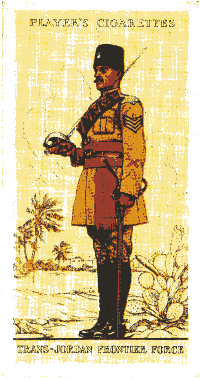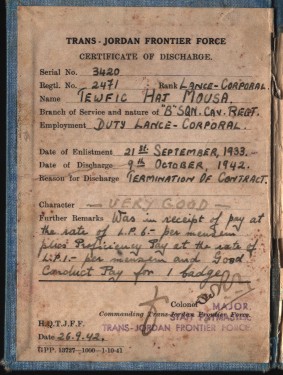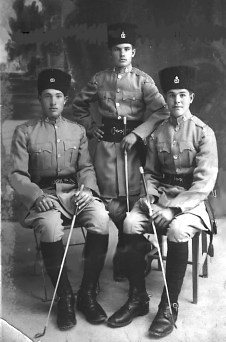 |
TJFF badge |
 |
The Trans-Jordan Frontier Force
 The Trans-Jordan Frontier Force was created on 1 April
1926, to replace the disbanded Palestine Gendarmerie. It was a creation of the
British High Commissioner for Palestine whose intention was that the Force should defend
Trans-Jordan's northern and southern borders. The High Commissioner had been impressed
with work done by The Arab Legion but local commanders thought
it unnecessary to create an additional force when expansion of The Arab Legion might have
been a better course of action. The Arab Legion immediately incurred a loss of more
than half of its forces when they were transferred as cadre for the Frontier Force.
The Trans-Jordan Frontier Force was created on 1 April
1926, to replace the disbanded Palestine Gendarmerie. It was a creation of the
British High Commissioner for Palestine whose intention was that the Force should defend
Trans-Jordan's northern and southern borders. The High Commissioner had been impressed
with work done by The Arab Legion but local commanders thought
it unnecessary to create an additional force when expansion of The Arab Legion might have
been a better course of action. The Arab Legion immediately incurred a loss of more
than half of its forces when they were transferred as cadre for the Frontier Force.
In addition to the drop in personnel, The Arab Legion was also stripped of its machine guns, artillery, and communications troops. Unlike the Arab Legion, the TJFF was responsible to the British High Commissioner in Jerusalem rather than to Amir Abdullah of Trans-Jordan. The Force officially came under British Imperial Troops and appeared in British orders of battle.
On creation at Sarafand on 1st April, 1926, with Lieutenant-Colonel FW Bewsher, DSO, OBE, MC, in command, the TJFF was organised into three cavalry squadrons (of 120 men each) and one camel company, together with six reserve troops (around 190 men). The first recruits to the TJFF were largely from the disbanded Palestine Gendarmerie. Arab peasants (fellahin) from Palestinian villages made up around 70 percent of the other ranks. There were some Sudanese in the camel company before 1930 when the company was replaced by a mechanised company. Jews and town Arabs, being better educated, served in the technical and administrative posts and by 1935 just under 25 percent of the Force were Circassians - a small ethnic, Muslim minority living in Trans-Jordan. The senior commanders were all British however junior officers were Palestinian Arabs, Circassians, Syrian Arabs, Sudanese and a few Jews. The Amir Abdullah was an Honorary Colonel of the Trans-Jordan Frontier Force from its inception.
The TJFF commander was a British lieutenant colonel, with Headquarters at Zerqa. Second-in-command was a British major, responsible for administration, workshops, quartermaster's stores and pay. The adjutant, also a British major, was responsible for training and personnel and was aided by an assistant adjutant who was a local Arab officer.
The squadrons and companies were all commanded by British majors, with another British officer as second-in-command. The cavalry squadrons were organised into three rifle troops (36 men) and one machine gun troop (36 rifles and 4 MGs). The normal tactical and reconnaissance unit however, was the half-squadron or half-company and these were commanded by local captains. Each half-squadron or company consisted of two troops, led by local lieutenants and captains. By the end of 1927 there were 39 officers (17 British), 12 warrant officers (all British), three staff sergeants and 676 other ranks. In 1930 there were 17 British officers, two in each of the four squadrons and companies with the remainder at Force HQ. In 1935 there were 24 British officers - the CO, seven majors and sixteen captains. Lieut-Col Bewsher relinquished command of the TJFF in 1928 and rejoined his Regiment in the Regular Army. Command of the Force passed to Major (local Lt-Col) CA Shute, CBE, Indian Army, previously second-in-command.
The TJFF spent its first six months training in Palestine, first at Sarafand then, from October 1926, at Shunet Nimrin in the Jordan Valley. Shortly after the HQ moved to Zerqa, Trans-Jordan, east of the Jordan River. The cavalry squadrons were based at Zerqa and the camel company at Ma'an. In 1929, the TJFF was called upon to help deal with Arab unrest in Palestine. The camel company moved to Jericho and a cavalry squadron went to Jisr el Majamie. In early 1930 a second cavalry squadron was despatched from Trans-Jordan as reinforcement.
In 1930, a mechanised company was formed and later that year the camel company disbanded. The addition of motorised troops extended the range of TJFF troops for it had been discovered that the horsed cavalry was unable to travel far into the desert. The new mechanised company was based at Ma'an. During the year the strength of the TJFF was 980 men, including 28 Jews.
The TJFF, while more smartly turned out and drilled than the more pragmatic Arab Legion, was not regarded as an elite force and it must be remembered that it primary role was that of police or gendarmerie. The Force had encountered great difficulties pacifying the desert tribes and in February 1931, Glubb, second-in-command of the Arab Legion reached an agreement with the TJFF that saw the withdrawal of outlying TJFF detachments from the desert to Zerqa and Ma'an, leaving the desert to be patrolled by Glubb's newly formed Desert Patrol.
TJFF Stations - 1933 |
|
| Zerqa (Trans-Jordan) | HQ Wing |
| one cavalry squadron | |
| one mechanised company | |
| Ma'an (Trans-Jordan) | one mechanised company |
| Jisr el Majamie (Trans-Jordan) | squadron HQ and a half-squadron of cavalry |
| Beison (Palestine) | a half-squadron of cavalry |
| Samakh (Palestine) | squadron HQ and a half-squadron of cavalry |
| Rosh-Pinah (Palestine) | a half-squadron of cavalry |
In 1933 a second mechanised company was formed and further expansion occurred after the outbreak of the Second World War, in late 1940. In 1933 also, Lt-Col Shute completed his period of command of the Trans-Jordan Frontier Force, and was succeeded by Major (local Lieutenant-Colonel) CH Miller, 13/18th Hussars. Throughout this pre-war period, the TJFF was called upon to help quell Arab unrest (in protest at rising Jewish immigration) and, later, to help control Jewish immigration. At the same time, The Jewish Agency continually called for additional recruitment from the Jewish community. During November 1937, military forces together with the Police and the Trans-Jordan Frontier Force undertook an extensive operation near the Syrian frontier as a result of which a large gang was located and dispersed with casualties. The Force frequently participated in this kind of action and there was a steady trickle of casualties. The cost of operating the Force may be indicated by the British grant for the TJFF for 1938 which was a sum of 200,000 Lebanese pounds.
|
|
On 1 January 1941, the cavalry squadrons were formed into 1st Cavalry (Horsed) Regiment at Jisr el Majamie followed in February by the formation of the 1st Mechanised Regiment (from the two mechanised companies) at Irbid. A Line of Communication Squadron was raised to protect the Baghdad-Haifa road.
The first call to action was something of a disaster. The Mechanised Regiment was earmarked to join Kingcol, part of Habforce, in the relief of Habbaniya in Iraq in April 1941. ' D' Company of the Regiment was at the H4 pumping station on the Iraq Petroleum Company pipeline but when ordered to advance against Rutbah, the men refused to cross the border into Iraq. As a result, the Mechanised Regiment was excluded from the subsequent campaign and ' D' Company was disbanded. It was replaced by ' L' Company, formed from the Line of Communication Squadron. A new squadron, the Mobile Guard Squadron, was formed to take over the line of communication duties.
 |
| TJFF
Certificate of Discharge, 26th September 1942 (photo: Maj Tawfiq Mousa
Ahmed)
(Click the image to see original, full size) |
During this period, the cavalry squadrons were sent to Irbid-Jordan to ensure the security of the region. A watch was also maintained on the Syrian border in case of infiltration by pro-Axis troops.
A better performance was achieved when in June 1941, both the Cavalry and the Mechanised Regiments joined British and Commonwealth forces in the Syrian campaign. The TJFF regiments supported the 5th Indian Infantry Brigade advance on Damascus, via Deraa, Sheikh Meskine and Kuneitra. The TJFF acted as advance guard, scouts and flank protection. They were given the special task of protecting the railway line, with the horsed and mechanised regiments being given their own sectors to patrol. Following the conclusion of the campaign, the TJFF left Syria in the Autumn of 1941, leaving behind cadres to instruct the newly formed Syrian and Lebanese armies.
In 1942, the Force was on the Turkish frontier on 'watch and ward' duties. In November 1943, the Mechanised Regiment left Zerqa for Bandar Abbas on the Persian Gulf to help with the Middle East Anti-Locust campaign. The regiment spent six months in Persia. The TJFF was at Jezireh, Syria, in 1944 helping to keep the Syrians and the French apart. At war's end in 1945, the Mechanised Regiment was in Syria and the Cavalry Regiment in northern Palestine.
|
|
After the end of the Second World War, there were attempts at a return to pre-war normality, such as the holding of the "TJFF Open Horse Show and Display" at Sarafand, on the 27th and 28th June 1947, in aid of the The Jerusalem Babies Home (Anna Spafford’s) and the TJFF Benevolent Fund. However, the Force now became involved in helping with British attempts to control the growing violence between the Arabs and the Jews in Palestine. It was a role destined to make the Force extremely unpopular and the last CO, Colonel Hackett (later General Sir John Hackett, former CO of 4th Parachute Brigade which fought at Sicily, Taranto and Arnhem), was informed in January 1948 of the intention to disband the Force. On 9 February, 1948 the Trans-Jordan Frontier Force was disbanded. Many members of the unit were absorbed into The Arab Legion.
With very special thanks to Major (retd) Tawfiq Mousa Ahmed (ex TJFF, Arab Legion and the Jordanian Armed Forces) for advice, personal reminiscences and photographs.
Links:
Palestine Police
Graham Jenkins, a former member of the Palestine Police and member of the Palestine Police Old Comrades' Association, maintains a website at: A Brief History of the Palestine Police Force
Sources:
Glubb, John Bagot, The Arab Legion, Hodder & Stoughton, London (1948)
Lunt, James, Imperial Sunset, Purnell (1981)
Pal, Dharm, Official History of the Indian Armed Forces in the Second World War, 1939-45 - Campaign in Western Asia, Orient Longmans (1957)
Roubicek, Marcel, Echo of the Bugle, extinct military and constabulary forces in Palestine and Trans-Jordan 1915,1967, Franciscan (Jerusalem 1974)
Vatikiotis, PJ, Politics & the Military in Jordan, a study of the Arab Legion 1921-1957, Frank Cass (1967)
Jordan – A Country Study, US Library of Congress
Regimental Standing Orders of the Trans-Jordan Frontier Force - 1933
The UN Information System on the Question of Palestine - reports on the administration of the British mandate, including:
Flag and pennant from Flags of the World
Thanks to David A Ryan, Todd Mills, Pat Brennan and Mac McQuinn.
04 January 2009
